All stats per 90 minutes and provided by StatsBomb via FB Ref
“When we can train, that means that we have time, because we are playing every three days and that makes it really difficult to do that. We just try to improve this situation,” said Mikel Arteta after defeat to Wolves.
The good news is that the manager knows Arsenal aren’t creating enough chances and he has acknowledged that it’s his job to change it. Whether or not he actually can do that remains to be seen.
There are reasons to sympathise with Arteta and his team right now. The schedule, and a lack of pre-season, makes things very hard to implement or to change. That sympathy is, of course, eroded when you think about the short-term approach and the money ploughed into contracts for 32-year-old Willian and 31-year-old Pierre-Emerick Aubameyang. Arsenal have to start winning or they’ve thrown all that money away. They didn’t have to invest heavily in the short-term but they did, and the short-term results are bad.
The bad news is, we don’t actually know if Arteta can get Arsenal to make more chances. The squad at his disposal isn’t optimally built but 10 Premier League goals in as many Premier League games leaves a lot of room for improvement, no matter what you think of the players. For all the issues with the squad, Arsenal had the fifth most goals and racked up the eighth most expected goals in the Premier League last season. So far this season, 15 teams in the Premier League have more goals than Arsenal and 11 have a higher expected goals tally.
Can Arteta fix the attack? How does he actually want his team to play? And did we actually improve after he came in last season?
Truth be told, the FA Cup win and (incredibly fortunate) defeat of Liverpool late last season did paper over some cracks and the numbers said it at the time. Just as they said that now infamous 22-game unbeaten run under Unai Emery was, well, not what our performances actually deserved. We all know how that went.
My latest #dataviz for @arseblognews looks at underlying trends and the similarities in honeymoon periods between Emery and Arteta.#arsenal #afc https://t.co/rXeGYFRcb0 pic.twitter.com/xW2LdA7m3q
— Jon Ollington (@jonollington) November 26, 2020
Under Emery last season, games became chaotic. The biggest question, when Ljungberg and then Arteta took over, was how to stop matches from being so wide open. Both managed that, sort of. Arsenal were at least conceding fewer shots. Under Emery in 2019/20, the team were leaking 16.5 shots per game. That number went down, a bit, to 13.8 under both Ljungberg and Arteta. It’s gone down a little more to 12.8 in 2020/21 so far, which is still only better than six other Premier League teams, and at what cost?
In Emery’s first season, Arsenal had 1.5 xG per 90 minutes. It’s not great, it’s actually a little worse than the 1.66 from Arsene Wenger’s final season in charge, but it was still the fifth best in the Premier League. It dropped to 1.35 in 2019/20 before the Spaniard was sacked. Ljungberg focused on making Arsenal less open, as he admitted at the time, and the number dropped further still, to 0.97, before it picked up to 1.41 per 90 under Arteta. That isn’t a great return – it would be the 11th highest xG/90 in the Premier League so far this season – but it’s a damn sight more than 1.13 Arsenal are putting up in 2020/21.
Expected goals aside, we can use other stats to paint an incredibly unflattering picture of Arsenal’s style under Arteta so far.
By watching games and looking around at other stats, we can paint a stylistic picture. We see Arsenal are passive and slow. Mikel Arteta’s side apply the second least pressures to opposition players on the ball than any other team in the league. Arsenal’s pressures are only behind Man City’s, who allow their opponents the second fewest passes in the league, while ours have the seventh most. Arsenal also have just the 15th most pressures in the opposition third, while City have the ninth most. Arsenal attempt (and win) the least tackles in the league. Jon Ollington’s recent look at Arteta’s Arsenal on arseblog news showed just how passive Arsenal are compared to the rest of the league.
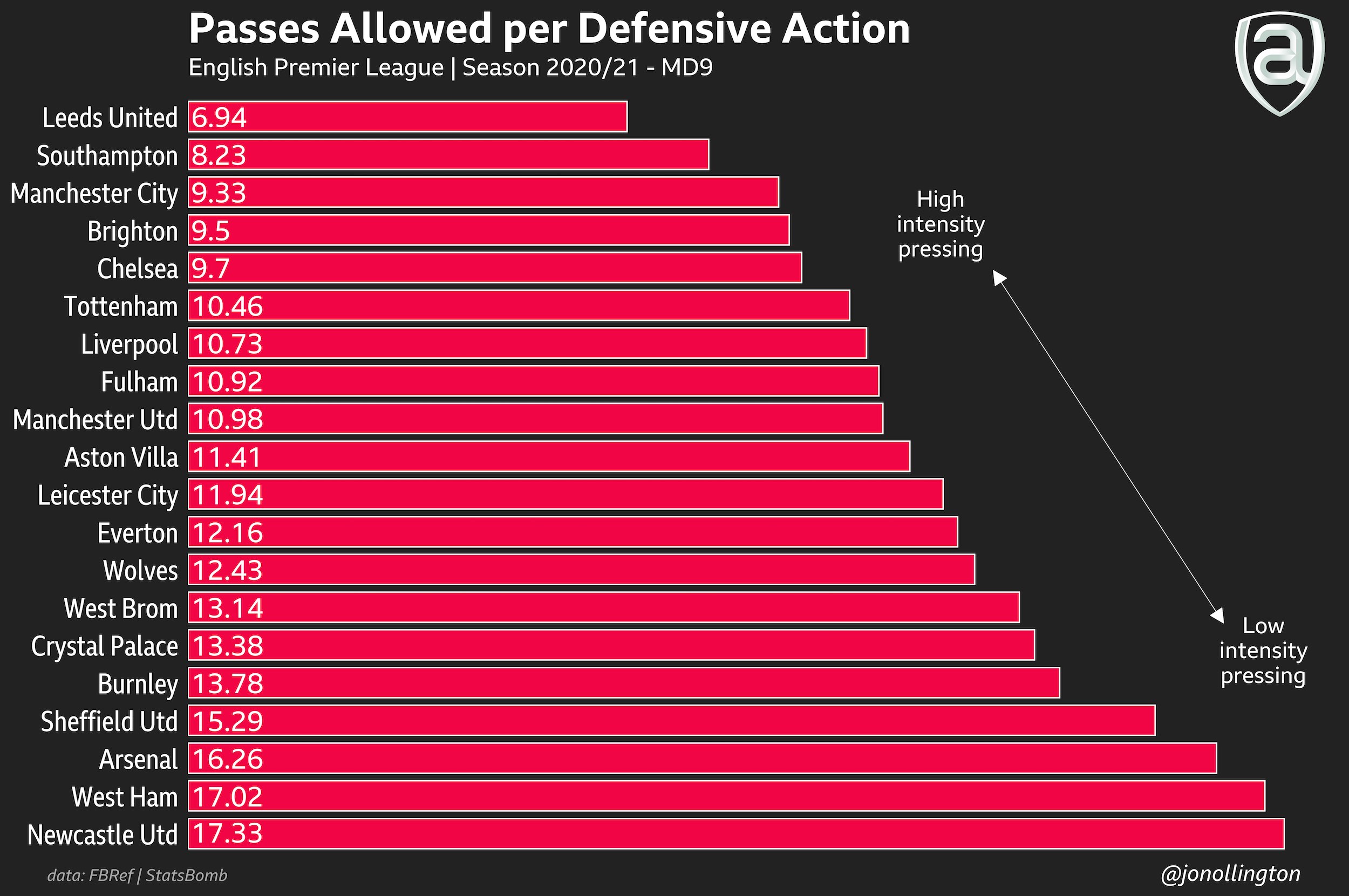 Arsenal, basically, just aren’t a horrible team to play against. Unlike Leeds, who hurried us into every pass we made at Elland Road, our attempts to press are often too loose to actually see us win the ball.
Arsenal, basically, just aren’t a horrible team to play against. Unlike Leeds, who hurried us into every pass we made at Elland Road, our attempts to press are often too loose to actually see us win the ball.
Perhaps, with no pre-season and no real training sessions, Arteta has decided the safer way to play for now is to try and stop teams progressing through the middle of the pitch, rather than actively trying to win the ball as close to their goal as possible, hence the role of Alexandre Lacazette. As a result, Arsenal are often forced deeper and end up defending their own box. But that brings its own problems, at the back and going forward.
Relying on organisation and a strict, deep shape to keep opponents out, Arsenal are being pushed back and pressure builds. With so many players so far back, there is no outlet. There is nobody to challenge for second balls. There is no counter-attacking threat. In the example below, Arsenal have 8 players within the last 18 yards of the pitch and Gabriel’s clearance landed with the Wolves players outside the area on the left of the picture.
 When you get pushed back like this many of your outfield players, there is no hope of counter-attacking any clearance invariably bounces to an opposition player, as it did just minutes earlier against Wolves.
When you get pushed back like this many of your outfield players, there is no hope of counter-attacking any clearance invariably bounces to an opposition player, as it did just minutes earlier against Wolves.
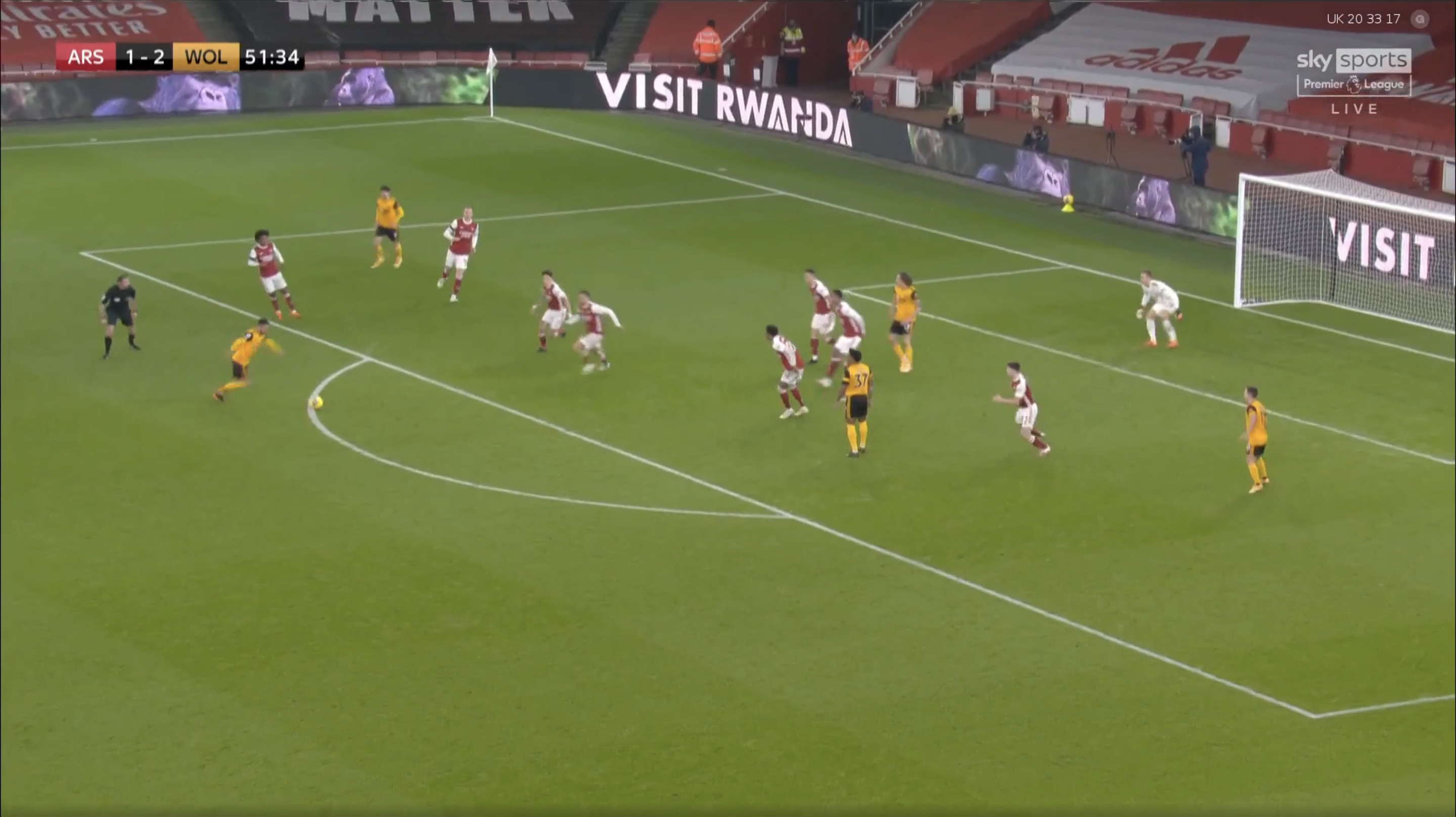 Even before a clearance or rebound has the chance to make it to the edge of the box, players arriving late can be completely unmarked no matter how many bodies you have back.
Even before a clearance or rebound has the chance to make it to the edge of the box, players arriving late can be completely unmarked no matter how many bodies you have back.
The scariest thing about Aston Villa’s disallowed goal in the opening minutes a few weeks ago was how Arsenal could possibly have every single player back, but with little pressure on the ball, nobody blocking a ball into the near post, and nobody cutting out the pass to John McGinn.
 What are Bellerin, Tierney, Partey, Aubameyang, Willian actually providing in that scene? When so many players look helpless and caught out, even though they’ve all made the effort to get back, it’s the system that has to go under the microscope.
What are Bellerin, Tierney, Partey, Aubameyang, Willian actually providing in that scene? When so many players look helpless and caught out, even though they’ve all made the effort to get back, it’s the system that has to go under the microscope.
Arsenal are just as passive and cumbersome with the ball. They have the 4th most touches per 90 minutes in their own defensive third but the 12th fewest touches in the opposition third and opposition penalty area.
And they are risk averse. Attempting the fewest tackles is a mark of a team that doesn’t want to commit to being out of position in case they get beaten. But, like above, it more often than not puts us in more trouble. On the other side of the coin, Arsenal have completed fewer dribbles than 17 of the other 19 Premier League sides. That’s certainly ne way to make yourselves easy to defend against.
The team’s passing is 15th for progressive distance (the distance the ball moves towards the opposition goal) per 90 despite only seven teams attempting more passes per game. No team in the league loses possession through a ‘miscontrol’ less often, only one team has had their players dispossessed less regularly. Because Arsenal don’t take risks.
Mikel Arteta, to his credit, has now tried to change things. He has put Pierre-Emerick Aubameyang up front, and put Joe Willock in midfield, and shifted to a back four. If anything, we now look just as blunt but even more wide open defensively. It doesn’t matter how we line up, we don’t have the ball in dangerous areas.
The data is not entirely complete because I use it mostly for testing but here you go: https://t.co/cij7nJnlyS pic.twitter.com/6hmjndupOh
— Piotr Wawrzynów (@pwawrzynow) November 30, 2020
This is a choice. It’s a choice to have extra players out wide, further from the goal. It’s a choice to have extra players in the build up, even when it’s not necessary. It was a choice to play like this against Wolves, just as it has been in so many of our games, and it isn’t working.
No wonder Arsenal struggle to get the ball into areas higher up-field when they don’t have any bodies there to receive possession. What, in this moment against Wolves, is the point of Ceballos collecting the ball from Gabriel, instead of letting Gabriel carry it into that space and pushing ahead to provide him with an option through the lines?
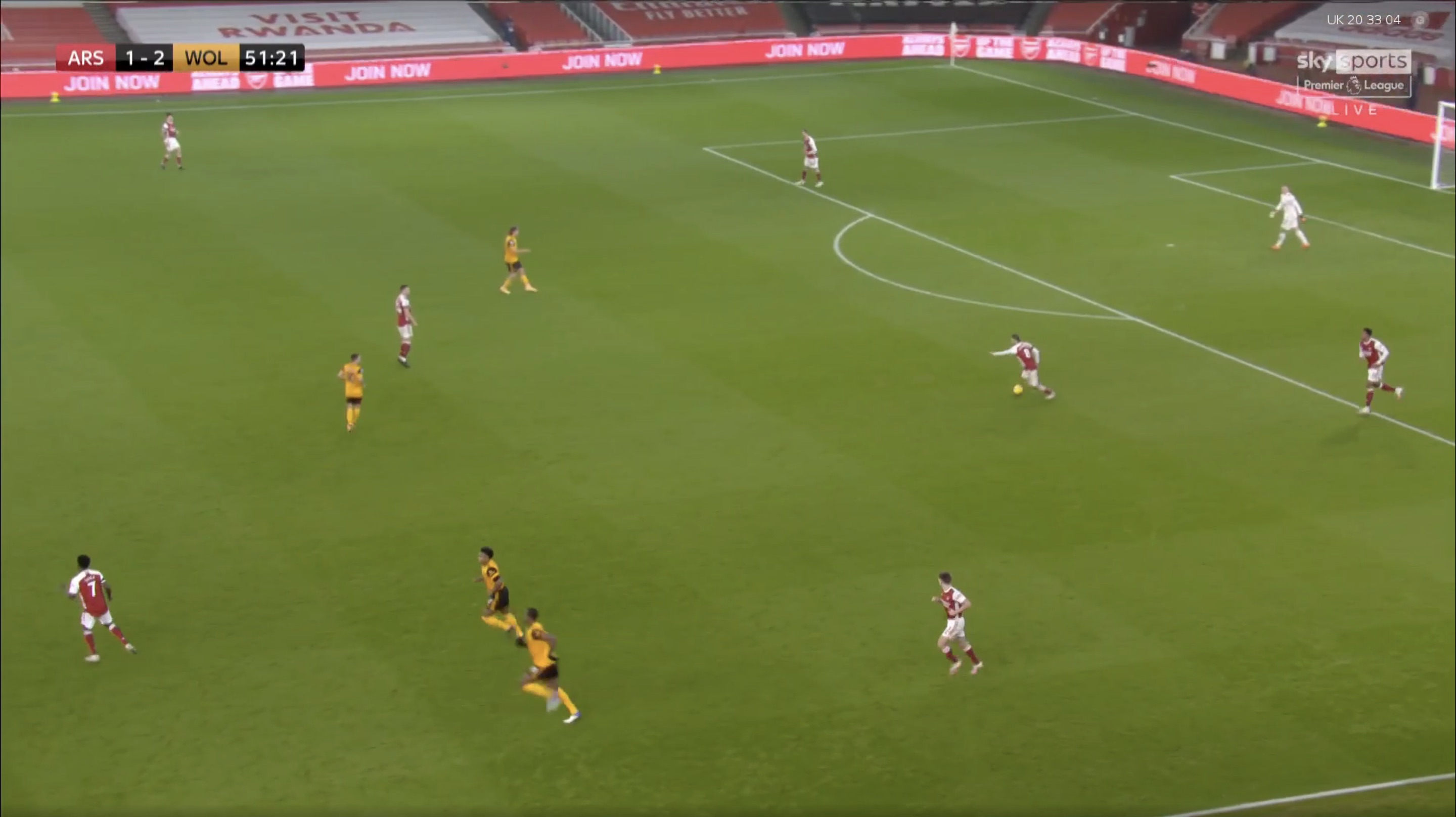 And what do Kieran Tierney’s team-mates expect him to do with possession here when so many of them – 8 of 10 outfielders – aren’t standing beyond a single Wolves player? How is this Arsenal side set up to bypass opposition players?
And what do Kieran Tierney’s team-mates expect him to do with possession here when so many of them – 8 of 10 outfielders – aren’t standing beyond a single Wolves player? How is this Arsenal side set up to bypass opposition players?
 It’s now a worry that Arteta has tried new players and moved players around and changed the basic system, against Leeds we even stopped trying to play through their press, but we have barely altered the spaces we occupy when we attack. It’s little wonder we had the joint-most attempted crosses by a PL team in a game this season on Sunday; there’s nobody in the middle of the pitch to pass to.
It’s now a worry that Arteta has tried new players and moved players around and changed the basic system, against Leeds we even stopped trying to play through their press, but we have barely altered the spaces we occupy when we attack. It’s little wonder we had the joint-most attempted crosses by a PL team in a game this season on Sunday; there’s nobody in the middle of the pitch to pass to.
Arsenal attempted 31 open-play crosses against Wolves, the joint-third-most by any team in a single Premier League game this season.
Only three were successful. 😬 pic.twitter.com/xUDbTbDcLV
— Squawka Football (@Squawka) November 29, 2020
Joe Willock’s natural game, as we’ve seen in the Europa League, is to drift into the channels to provide an option. See where he touched the ball in the 4-1 home win over Molde (with Arsenal shooting left to right).
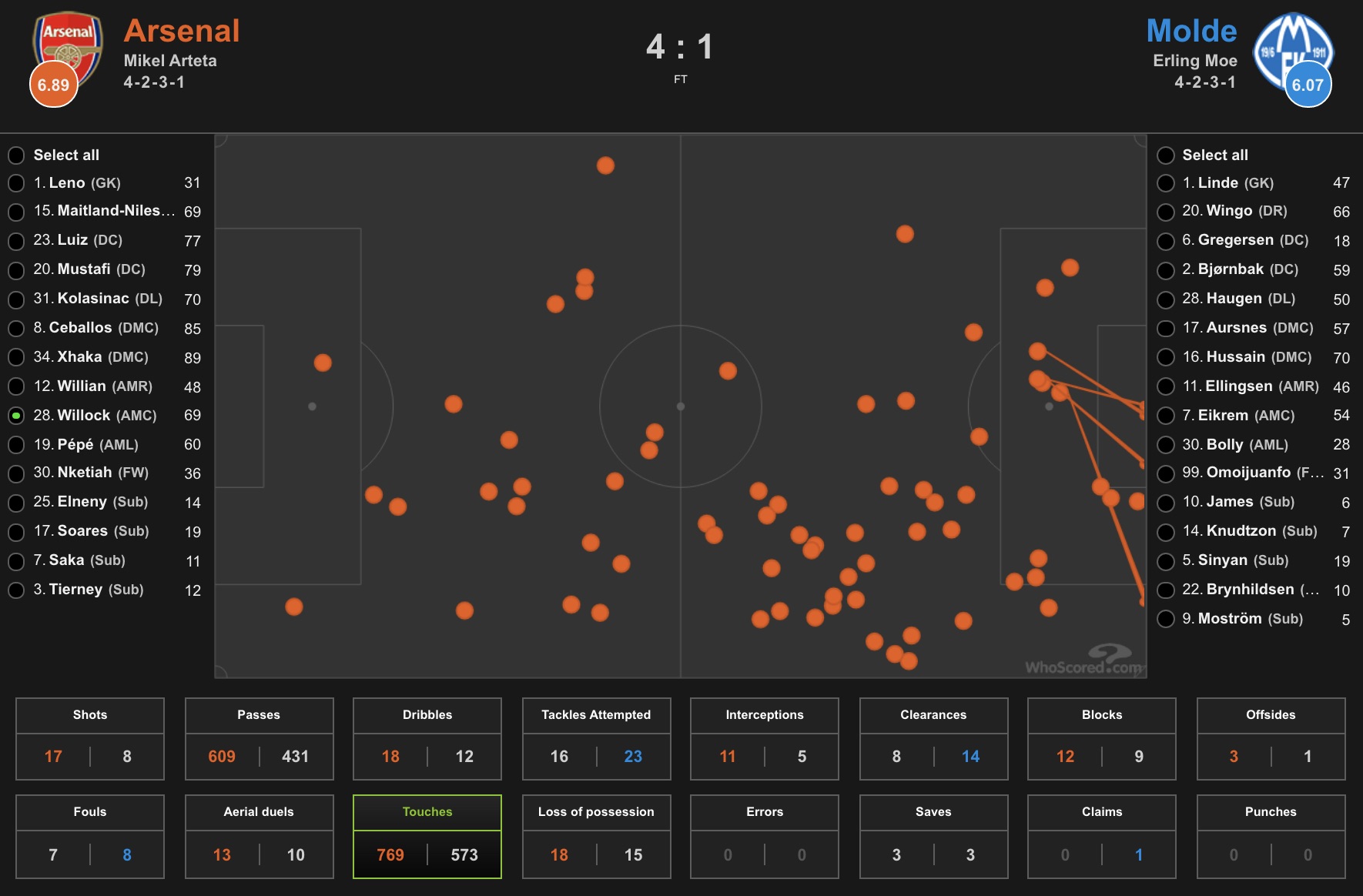 Or in his 57 minutes in the 0-0 draw at Leeds (with Arsenal shooting right to left).
Or in his 57 minutes in the 0-0 draw at Leeds (with Arsenal shooting right to left).
 But he was bizarrely pegged to the touchline against Wolves on Sunday, mostly combining with Bukayo Saka and Kieran Tierney. It says plenty about where we are that there are hopes Willock can jump up a level and make a difference for this team, but if he’s going to do it, it will probably at least be in his natural role.
But he was bizarrely pegged to the touchline against Wolves on Sunday, mostly combining with Bukayo Saka and Kieran Tierney. It says plenty about where we are that there are hopes Willock can jump up a level and make a difference for this team, but if he’s going to do it, it will probably at least be in his natural role.
 When he did drop inside hoping to receive the ball, he was ignored, presumably because it was the plan to shift the ball wide and try to make space to swing in a cross.
When he did drop inside hoping to receive the ball, he was ignored, presumably because it was the plan to shift the ball wide and try to make space to swing in a cross.
 Just look at the body shape of Wolves centre-back Willy Boly as Willock moves infield. He’s wary of the pass going in there and looks to engage him. These are the movements we see far too rarely from Arsenal in the final third, and right here is great example of how effective they can be in pulling defenders out of possession. Unfortunately, Gabriel plays the ball to Saka and Arsenal are forced to go backwards after finding themselves down a cul-de-sac.
Just look at the body shape of Wolves centre-back Willy Boly as Willock moves infield. He’s wary of the pass going in there and looks to engage him. These are the movements we see far too rarely from Arsenal in the final third, and right here is great example of how effective they can be in pulling defenders out of possession. Unfortunately, Gabriel plays the ball to Saka and Arsenal are forced to go backwards after finding themselves down a cul-de-sac.
Loading up the wings isn’t ‘wrong’ or ‘not the way to play’ football, it has its advantages, but Arsenal aren’t finding them. An Aubameyang cross in this situation makes little sense, with Saka having to do more to make a run in behind. Even if he doesn’t receive the ball, he’d at least drag out one extra defender who was waiting for the cross into the area.
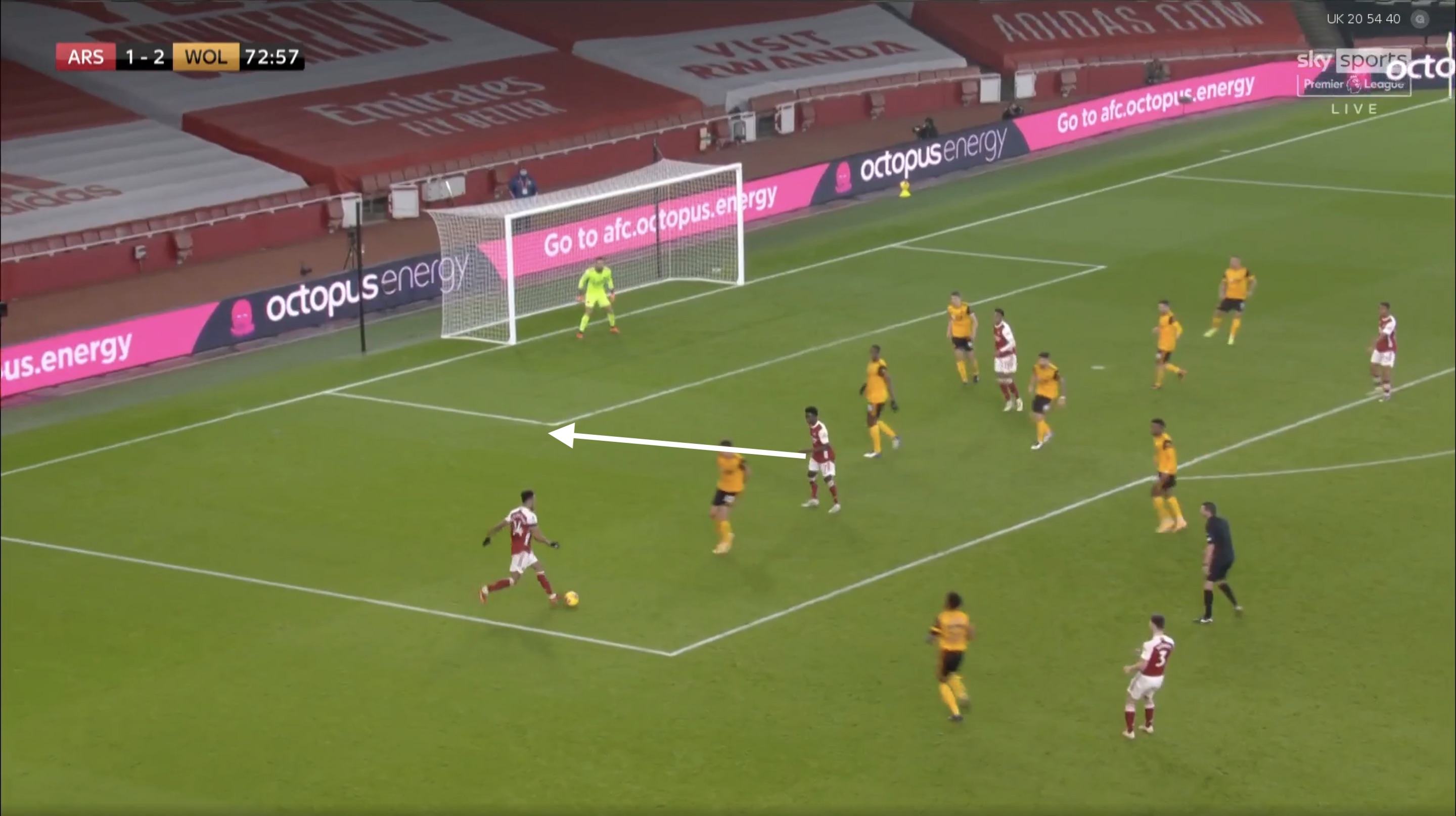 And what’s the point of overloading on one flank, only to not take advantage by switching play when you’ve dragged the opposition over to one side of the pitch?
And what’s the point of overloading on one flank, only to not take advantage by switching play when you’ve dragged the opposition over to one side of the pitch?
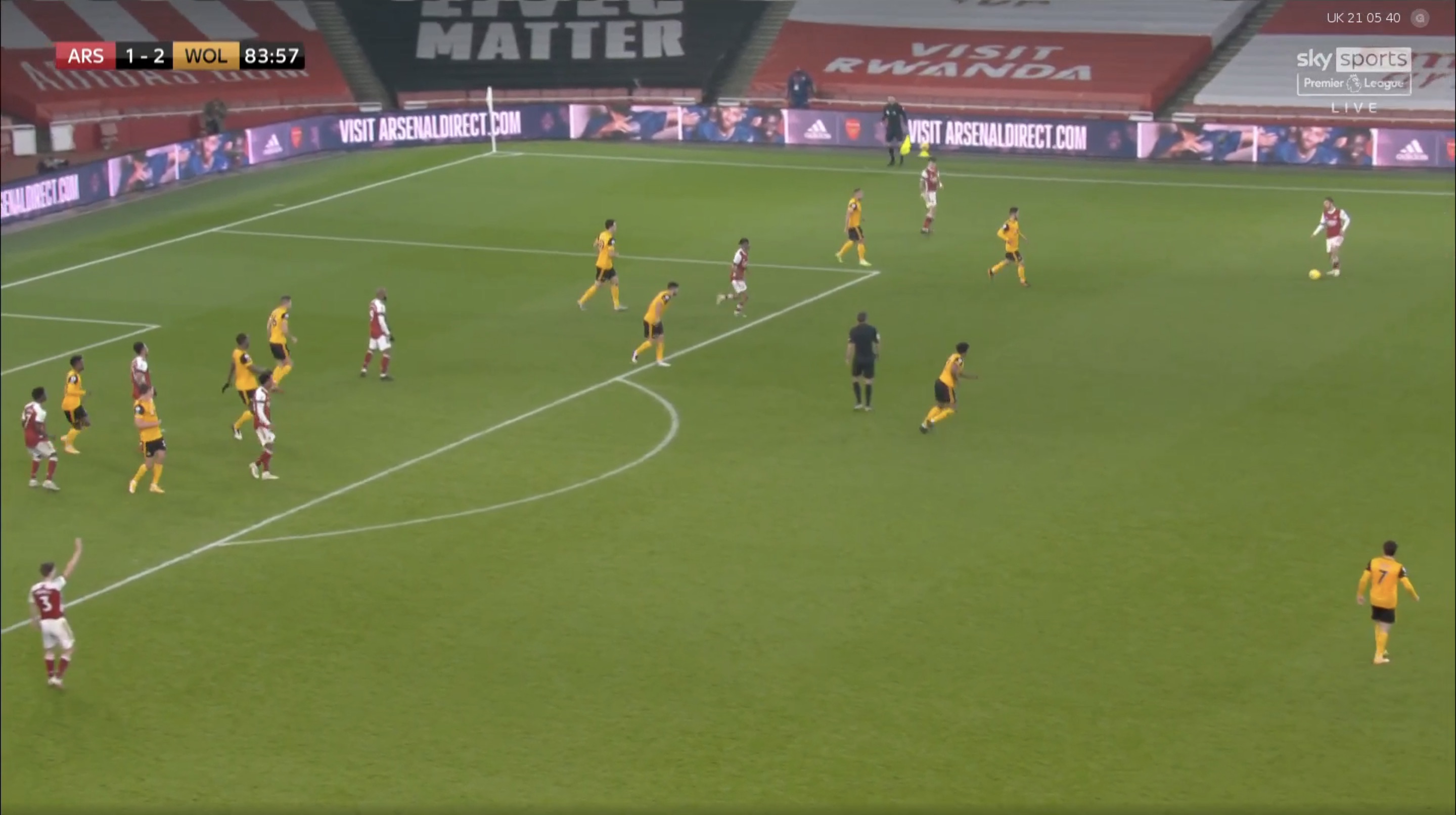 In the above example, Ceballos plays the ball back out to Bellerin, who plays it inside to Nelson who is surrounded and looses possession with a loose touch. All while four Arsenal players are with four Wolves players within the width of the six-yard box and Tierney is wide open at the back post.
In the above example, Ceballos plays the ball back out to Bellerin, who plays it inside to Nelson who is surrounded and looses possession with a loose touch. All while four Arsenal players are with four Wolves players within the width of the six-yard box and Tierney is wide open at the back post.
It’s a common theme and it’s exacerbated by how slowly Arsenal are moving the ball.
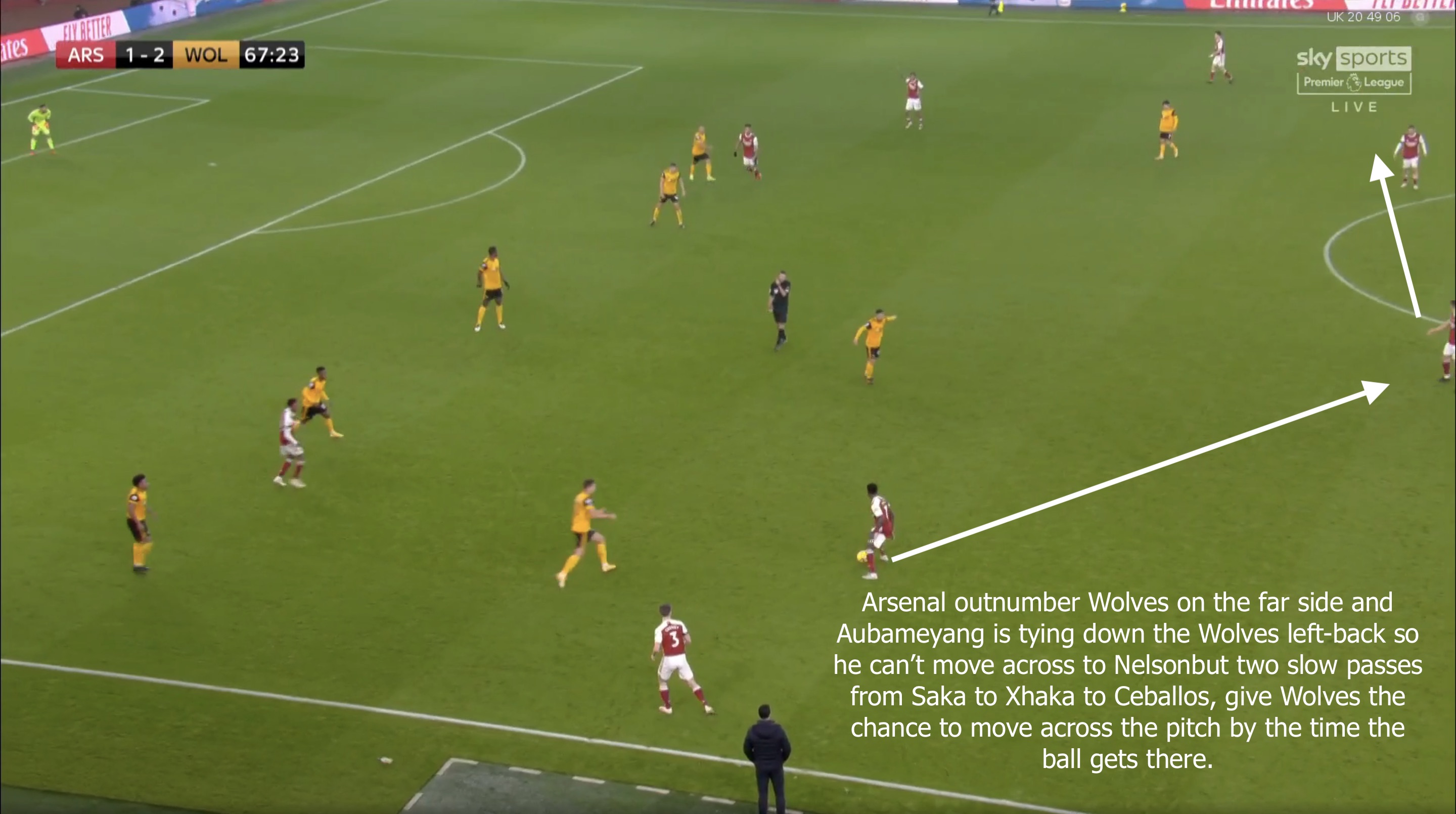 It doesn’t have to be a switch of play – with more movement Arsenal can also occupy the Wolves defenders on the near side of the pitch, opening up space for Aubameyang, or Willock, or making the switch to the far side easier by dragging those defenders further across the pitch.
It doesn’t have to be a switch of play – with more movement Arsenal can also occupy the Wolves defenders on the near side of the pitch, opening up space for Aubameyang, or Willock, or making the switch to the far side easier by dragging those defenders further across the pitch.
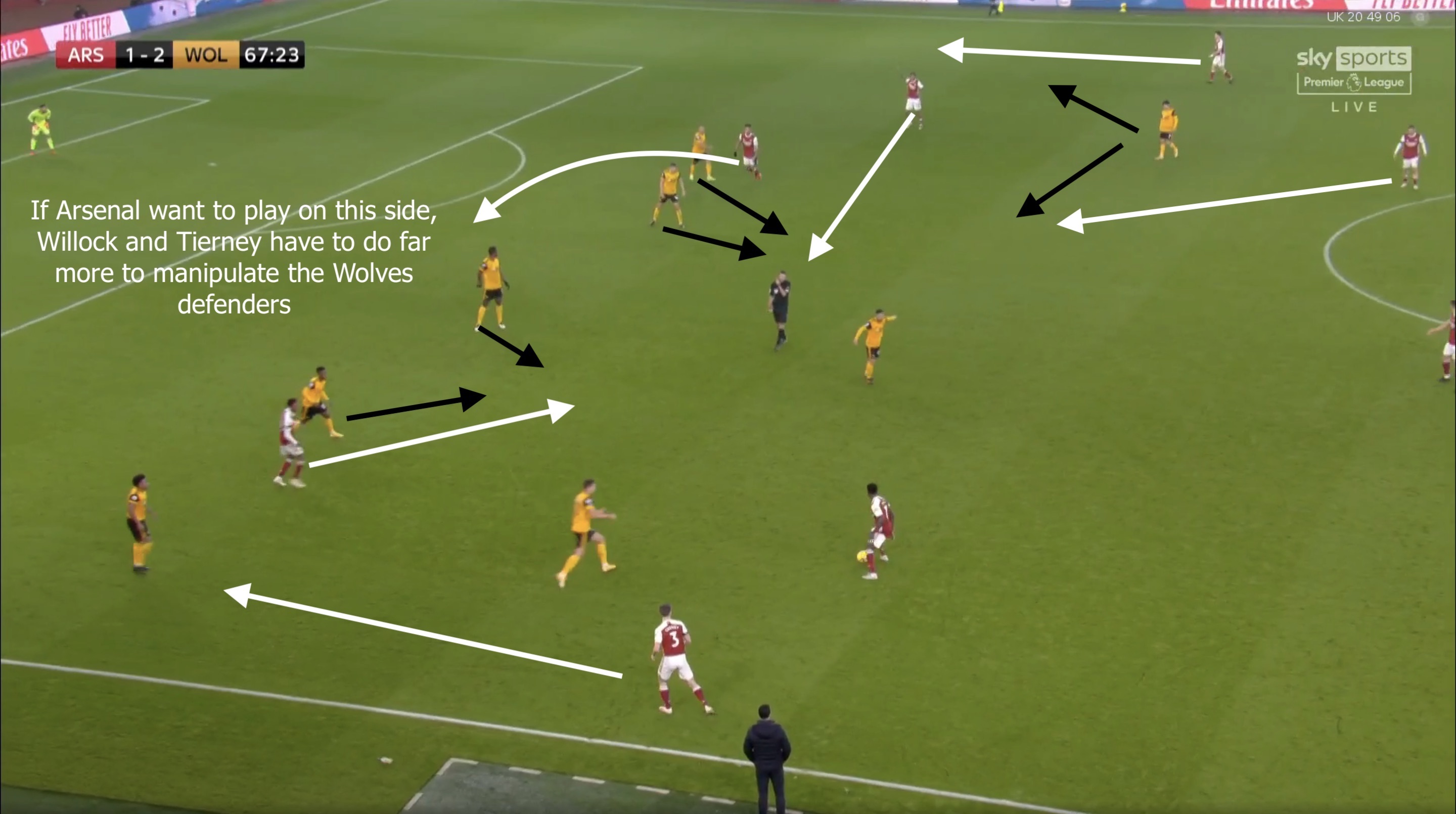 Movement forces defenders to make decisions. Does Pedro Neto, on the left for Wolves, follow Bellerin or Ceballos if they both push on? Does Boly have to come out of the back-line again if Willock drifts inside? Who tracks Aubameyang if he makes that run across the box? Or Nelson if he runs across the two defenders on that side of the pitch?
Movement forces defenders to make decisions. Does Pedro Neto, on the left for Wolves, follow Bellerin or Ceballos if they both push on? Does Boly have to come out of the back-line again if Willock drifts inside? Who tracks Aubameyang if he makes that run across the box? Or Nelson if he runs across the two defenders on that side of the pitch?
As long as Arsenal are not giving opposition players these problems to ponder, the attack won’t improve. We’ve tried the back four, with tried Aubameyang down the middle. We’ve put Willock in the team. We’ve dropped players, we’ve reinstated them.
Mikel Arteta knows he needs to find more goals from somewhere, but he’s going to have to change his approach and let his players play through the middle of the pitch if he wants to find them. The formations we’re familiar with were once famously dismissed as “nothing more than telephone numbers” by Pep Guardiola. Back three, back four, midfield three, midfield two. It’s all a distraction.
Arsenal aren’t going to improve no matter how the team is lined up unless the approach is altered.


